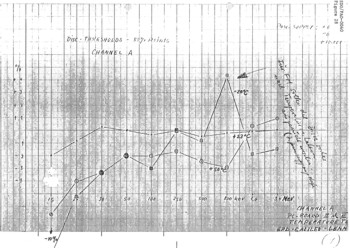The Galileo Energetic Particles Detector
Galileo EPD Handbook
Chapter 1. Instrument Summary
LEMMS Subsystem Overview (continued)
Source: W. Studemann, SDO/PAO, Jan. 20-21, 1981
Figure 1-53 shows changes in the 50% point on the discriminator curve with temperature on Board II. The curves were normalized at 23 degrees C (room temperature). Each labeled point on the X axis represents a different discriminator.
Figure 1-54 shows the probability of noise occurrence versus energy threshold for channel E1. This graph was taken with the main flight model amplifier and the preamplifier from the engineering model. This graph does not include detector noise.
 |
Figure 1-53. 50% point on the discriminator curve on Board II. |
 |
Figure 1-54. Noise occurrence vs. energy threshold for channel E1. |
Figure 1-55 shows the after ringing that occurs after a 10 MeV pulse from electron detector E1. This ringing has a frequency of about 20 kHz. This may be caused by crosstalk in the multilayer circuit boards, and is being checked out at Dornier. Figure 1-56 shows the same ringing problem on Channel A.
 |
Figure 1-55.After ringing on channel E1 after a 10 MeV pulse. |
Figure 1-56. After ringing on channel A.

Figure 1-57 shows a graph similar to the one in Figure 1-53. The 15 keV and 800 keV are out of the range required in the flight unit.
Figure 1-58 shows a small amount of crosstalk from the discriminator when it fires at the level shown. This may pose a problem if the channel output is fed to the PHA.
 |
Figure 1-57. Discriminator thresholds - 50% points, channel A. |
Figure 1-58. Crosstalk on channel A.

Return to Galileo EPD Handbook Table of Contents Page.
Return to main
Galileo Table of Contents Page.
Return to Fundamental
Technologies Home Page.
Updated 8/23/19, Cameron Crane
QUICK FACTS
Mission Duration: Galileo was planned to have a mission duration of around 8 years, but was kept in operation for 13 years, 11 months, and 3 days, until it was destroyed in a controlled impact with Jupiter on September 21, 2003.
Destination: Galileo's destination was Jupiter and its moons, which it orbitted for 7 years, 9 months, and 13 days.



